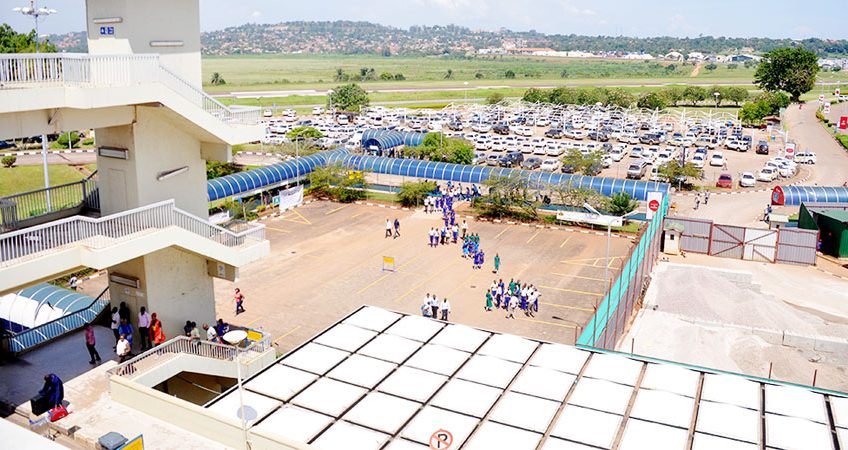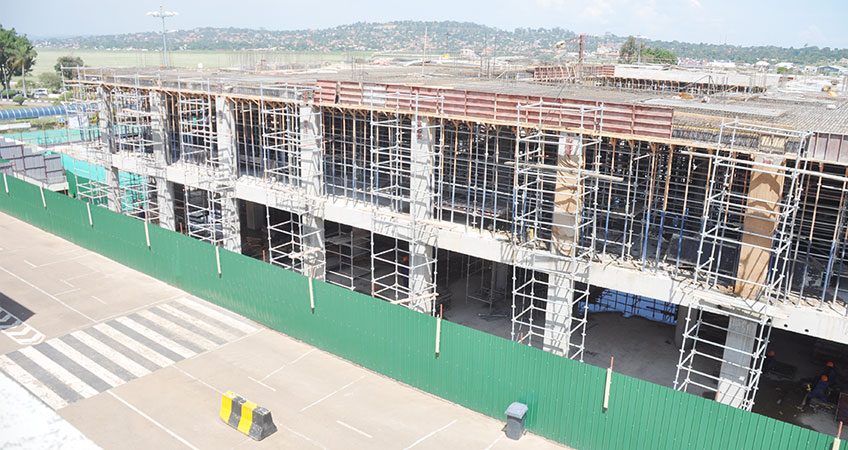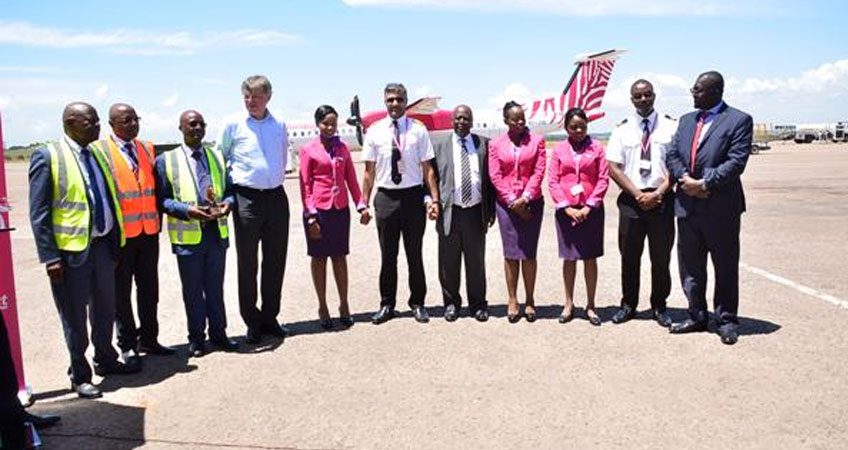
Blog


World Airline Body Meet in Kampala
Civil Aviation Authority (CAA) has expressed determination to expand and reinvigorate the country’s aviation industry, to make it one of the key enablers of Uganda’s economic development.
CAA Managing Director Dr. David Kakuba last night reiterated the Authority and government’s commitment to build a “strong, safe and secure aviation sector that support’s the country’s social economic development.”
CAA was hosting members of the International Air Transport Association (IATA) at a conference held at Sheraton Hotel on Thursday night.
The association has over 270 member airlines and represents about 83% of the world’s air traffic.
The body meets every year in different member countries for what is known as the IATA Day, and this year for the first time, Uganda was the host.
At the event, Dr Kakuba highlighted a number of strategies and projects that Uganda is undertaking to revive and revitalize its aviation industry, among them the USD 300million expansion and upgrading of Entebbe International Airport.
The project progress, he said, currently stands at 26% and is projected to be completed in the couple of years.
“Government of South Korea through the Korea International Cooperation Agency (KOICA) extended a grant of $9.5million towards the automation of systems at Entebbe International Airport,” Dr Kakuba revealed.
“There are a number of other ongoing works for the expansion of the passenger terminal building from internally generated revenue to enhance passenger facilitation and meet the growing traffic needs.”
On his part, Minister of State for Works and Transport Aggrey Henry Bagiire, emphasized the significant contribution of the air transport to the national economy, which he said is the reason Government considers such meetings a great tool in improving the sector seriously.
“One of the strategies to ensure continuous improvement has been stakeholder engagements to ensure that we get the views and concerns of industry players so as to address them for an efficient, safe and secure operating environment,” the minister said.
He cited other projects and programs that government is working on such as construction of Kabale International Airport in the Albertine Region, the ongoing review of the Aviation legal framework as well as encouraging more domestic and international airlines to start operations in Uganda.
“One of government’s main objectives is to make Uganda one of the best connected countries in Africa,” he added.
Adopted from: chimpreports (Friday November 10 2017)

Master Plan and Engineering Designs For Kabaale Airport in Hoima

Construction of a New Terminal Building
On completion of the new Cargo Centre by the end of 2018, the current structure used in facilitating cargo operations will be razed down and in its place a new terminal building will be constructed connecting to the existing terminal. Works on the new terminal will be undertaken by China Communication Construction Company (CCCC) from 2019 – 2021.


Landside expansion of the Passenger Terminal
The landside expansion by M/s Seyani Brothers (U) Ltd seeks to provide more room and comfort for service users, especially passengers. On completion, the project will deliver a new Arrivals and Departure block. It is fully funded by CAA to the tune of 42 billion shillings from internally generated revenue.
The existing Passenger Terminal building was opened in 1974 for peak hour traffic of 250 arriving and 250 departing passengers. The Terminal got some limited improvements as the country prepared for the Commonwealth Heads of Government Meeting (CHOGM) in 2007, elevating it to the current capacity of 410 arriving and 360 departing passengers.
The Master Plan projects 930 arriving passengers and 820 departing passengers during peak hours, by 2033. The expansion is critical in providing for the growth and ensuring a good customer experience.

Amended CAA Act to support aviation growth
State minister for Transport Aggrey Bagiire has appealed to Members of Parliament (MPs) on the Infrastructure Committee to support a proposed amendment of the Civil Aviation Act 2017 CAP354 to promote growth of the aviation industry by attracting more airlines into Uganda.
“The Bill will enable Uganda remain up-to-date with the International Civil Aviation Organisation (ICAO) Standard and Recommended Practices (SARPs) and comply with global uniformity for a safe, secure and efficient global travel environment,” he said.
Mr Bagiire made the remarks during a two-day meeting between MPs from the Physical Planning and Infrastructure committee and ministry of Works and Transport over the proposed amendment to the Civil Aviation ACT CAP354 in Entebbe recently.
He said the Bill aims at addressing key challenges that have negatively impacted Uganda’s scores in previous Universal Safety Oversight Audit Programme (USOAP) by the ICAO in their regular security and safety audits.
Need for amendment “Following the 2008 Universal Safety Oversight Audit Programme conducted by ICAO in Uganda, a number of gaps in our Primary legislation were identified and a corrective action plan was instituted necessitating amendment of the CAA Act Cap 354,” he said.
Dr David Kakuba, the managing director CAA, said the proposed amendment of the CAA Act is one of the action plans that will bring about efficiency in the operations of the CAA.
“The amendment will bring uniformity in all the Acts which are needed across all member states of ICAO and address issues of human trafficking and smuggling concerns,” he said.
Among other proposals, the Bill seeks to empower CAA management and the board to work with some autonomy to ensure quick decision making relating to safety and security. Others are; creation of an independent accident investigation unit separate from CAA which will ensure responsive and coordinated response to aviation accidents and incidents among other things.
The chairperson of the committee, Ms Lillian Nakatte, said once CAA has autonomy following the laws governing other airports in the world, it will help attract more international traffic and increase the country’s revenue.
Adopted from: The Daily Monitor (Thursday November 30 2017)

Technological Advancements to Enhance Efficiency in the Ugandan Airspace
Technology is changing so fast in the aviation industry that airports and regulators have to invest heavily in new and more efficient facilities and equipment for provision of services in order to remain competitive. The Ugandan aviation industry is no exception to this global village trend and Civil Aviation Authority (CAA) has hit the ground running with adoption of various innovations and investments in modern and next generation technologies that match the demands of airlines and passengers.
The move is aimed at enhancing efficiency; saving time and costs incurred by air operators and other users of the air transport system. While some of the advanced technologies are already in place, there are several new technologies that are going to be first tried and tested in 2018.
Uganda will start to enjoy the fruits of a US Dollar 9.5 million grant from the Korea International Cooperation Agency (KOICA) for a three year project for automation of Entebbe International Airport.One of the things it is going to help achieve is improvement in Flight Procedures efficiency. The current Flight procedures are under review by experts from Korea seeking to ensure that we have shorter and more direct air routes in the Entebbe Flight Information Region. The new improved procedure will reduce on the time spent by an aircraft flying within the Entebbe Area during approach, take-off and overflights.
The new flight procedures will also reduce on fuel burn and carbon emissions thus saving the environment, which has been adversely affected by climate change through global warming. Less aviation fuel burn will translate into cost savings for air operators while maintaining the save level of safety. New air routes will also come with the added
advantage of eliminating aircraft noise.
The positive developments will however require to be preceded with stakeholder engagement especially the air operators and military for harmonization of issues to do with routes close to prohibited areas and ensuring enhanced Civil-Military coordination.
The automation will also lead to improvement in flight plan coordination and exchange of aeronautical messages and data through delivery of an Air Traffic Services Massage Handling System (AMHS) for Entebbe and some upcountry aerodromes at Soroti, Gulu, Arua, Kasese and Nakasongola. The proposed new Kabaale International Airport will also be a beneficiary of this system. Installation, commissioning and testing of the new system by KOICA is expected to take place in early 2018. The AMHS will ensure reduced risk of errors and information loss.
Another key milestone is improvement of surveillance of the Ugandan airspace with introduction of new next generation (NEXTGEN) surveillance technologies such as the Wide Area Multilateration (WAM) and Automatic Dependence Surveillance-Broadcast (ADS-B), which will address surveillance gaps up to the ground level in airport areas and detection of low flying aircraft that are far from Entebbe. It will also fully address Air Traffic Management (ATM) requirements for modern aircraft using the Ugandan airspace.
2018 is also coming with replacement of the Automatic Weather Observation System (AWOS) for Entebbe and the Portbell Non Directional Radio Beacon (NDB), among others.
Already in place is the automation of the Aeronautical Information Management processes at Entebbe International Airportto enable automated management of flight plans, notices to airmen (NOTAM) and electronic Aeronautical Information Publications.
The new system has led to efficiency and reduction in costs incurred by air operators. Pilots and other airspace users now enjoy the convenience to perform flight planning and self-briefing using any web enabled device as all products and services provided by AIS can now be accessed online.
Participation in regional safety projects such as the East African Community (EAC), Northern Corridor, COMESA and Africa Indian Ocean (AFI) will continue. These regional projects and initiatives are aimed at regional implementation and harmonization of systems and procedures. Their ultimate goal is to establish a seamless airspace over region. This will facilitate improvements in airspace and airport capacity, safety, efficiency and environmental impact for aviation sustainability.
At the regulatory level, tremendous progress is anticipated in relation to management of drones in the Ugandan airspace. While Drones and or Remotely Piloted Aircraft Systems (RPAS) present many benefits to the users such as professional filming, photography and delivery of mail, among others, they also pose national security and safety concerns to other authorized users of the airspace. Some of the possible dangers includeaccidental collision of drones with passenger aircraft and misuse including breach of national and other people’s privacy. This calls for stringent and effective regulations in place for proper management of this versatile technological advancement.
There has been an influx of drones into the country, many of them have unfortunately been held up at customs at Entebbe International Airport pending fulfilment of security clearance and other procedural requirements.
The International Civil Aviation Organization (ICAO) has expressed commitment to develop “standards and recommended practices and guidance material to augment industry efforts to ensure appropriate training, licensing of personnel and operation and oversight of unmanned aircraft operations.”
An ICAO Remotely Piloted Aircraft Systems (RPAS) symposium was recently held in Abuja, Nigeria in July 2017 and the need for urgent development of regulations to cater for non-core aviation drone operators who are mainly interested in the gadgets’ benefits was emphasized. Uganda has made progress in this regard.
The draft set of Drone Regulations is already in place with inputs from security and is only pending harmonization with Regulations of the other East Africa Partner States. By the end of 2018, Uganda will have regulations that clearly separate and categorize drones from Remotely Piloted Aircraft Systems (RPAS). The RPAS are usually for commercial purposes and require the operator to get certification. These can even be used by couriers to deliver mail from one town to another, for instance Kampala to Arua. They are therefore operated Beyond Visual Line of Sight (BVLOS). Currently, CAA Uganda is only granting permission for usage of drones with Visual Line of Sight (VLOS), those that can be seen while being used.
By the end of 2018, it is anticipated that permission will be granted for usage of drones Beyond Visual Line of Sight as the formal guiding Regulations will already be formalized and in place after getting inputs from the regional member States.
Besides technology, several infrastructural projects will be up and running by the end of the year. A new 100,000 tones capacity Cargo Centre whose works are currently standing at 29 percent level of completion will be ready for use in October 2018.
Cargo volumes grew from 6,600 metric tons recorded in 1991 to 59,000 tons at the turn of 2016. Projections put the tonnage at 73,680 by the end of 2018 following a 5 percent average growth and at 172,000 by 2033.The new 100,000 tones capacity Cargo Centre will be a self-contained facility with a Parking Apron, landside and airside access roads, cooling facilities, a Freight Forwarders Parlor and ancillary business outlets. It is part of the US Dollars 200 million loan to Uganda by China through the Exim Bank of China. Part of the loan will be used to re-surface the Runways, Taxiways and strengthen and expand the Aprons under the same contractor, China Communications Company (CCCC). The supervising Consultant for the projects is Dar Al – Handasah Shair & Partners.
On completion of the new Cargo Centre, the current structure used for cargo operations will be razed down and in its place a new passenger terminal erected in a three year project commencing in 2019 and ending in 2021.
Other on-going works that will be ready by the end of 2018 include the expansion of the current passenger terminal building at Entebbe International Airport to create more room and maneuver for service users, especially departing passengers. The landside expansion by M/s Seyani Brothers (U) Ltd is fully funded by CAA from internally generated revenue.
The existing Passenger Terminal building was opened in 1974 for peak hour traffic of 250 arriving and 250 departing passengers. The Terminal got some limited improvements as the country prepared for the Commonwealth Heads of Government Meeting (CHOGM) in 2007, elevating it to the current capacity of 410 arriving and 360 departing passengers. The National Aviation Master Plan projects 930 arriving passengers and 820 departing passengers during peak hours, by 2033. With a 7.5 percent average growth, international passenger traffic is expected to be at 1,696,660 passengers through Entebbe by the end of 2018. The expansion is critical in providing for the growth and ensuring a good customer experience.

Aviation Health Tips
| with Dr. Eyul TK James, an Aviation and Public Health Specialist,
(MBChB, Msc CHHM-Heidelberg, AvMed-London) Question: If I have my passport complete with a visa, why should you ask for medical documents at Entebbe Airport? Answer: It’s always prudent to find out information about the destination you are heading to. Countries have different health requirements for people entering their territories and many countries require authentic proof of vaccination against yellow fever. This is a requirement by World Health Organization (WHO) under the International Health Regulations (IHR 2005) Annex 6 & 7. Uganda is near the Equator and therefore it is in the yellow fever belt alongside a few other countries like Brazil. Some countries like South Africa, Tanzania, Kenya, India, China and others wouldn’t permit someone originating from Uganda without the yellow fever vaccination card. World Health Organisation updates these countries every year and a traveller can check for the information from the WHO website. In the past, many people were also known to have forged yellow fever vaccination cards for purposes of travel and some of these cards have been detected in foreign countries, which has tainted the image of Uganda and its medical practices. This is one of the reasons checks at departure for the authenticity of the yellow fever cards were instituted to curb the vice. The Ministry of Health (MOH) vetted and signed a Memorandum of Understanding (MOU) with 22 health facilities under its supervision to administer the yellow fever vaccine. This is in line with the Public Health Act.
Question: Are passengers arriving in Uganda also required to have yellow fever vaccination cards? Answer: Passengers arriving in Uganda are also required to present authentic vaccination cards. Uganda is in the yellow fever belt and in the past few years there were some outbreaks that were well controlled by the Ministry of Health in conjunction with partners like WHO and CDC. Currently, arriving passengers without vaccination cards are vaccinated at their own cost (about USD 40) and issued the international vaccination card. At the moment Uganda does not isolate vaccinated passengers on arrival like some countries do, but advises them not to travel to areas with thick forests that harbour mosquitoes that spread the disease before the elapse of ten days during which the vaccine becomes protective against the disease.
Question: Which passengers are exempted from travelling with yellow fever vaccination cards? Answer: Pregnant women, babies below one year and persons with HIV/AIDS having a CD4 count below 200 are cleared by authorities to travel without yellow fever vaccination cards. Some people above the age of 60 years and others that are allergic to egg proteins have also been known to develop some minor skin rashes. Such people need to alert the health authorities and seek for an exemption letter to that effect.
Question: For how long does the yellow fever vaccine provide protection? Recent studies by WHO have shown that the vaccine can protect someone for life. Uganda adopted this policy effective July 2016. However, one should show proof of vaccination whenever they are travelling to a territory that requires it to avoid being vaccinated again. This does not cause any harm, but leads to unnecessary expenditure. Travellers are advised to handle their yellow fever vaccination cards the same way in which they handle their passports.
What should I do if I am travelling to a country with a cholera outbreak? Answer: You should get vaccinated against cholera. The World Health Organisation monitors all countries and issues alerts. It is important to read about a country you’re travelling to. Cholera is transmitted through feaco-oral route. Good sanitation practices and eating hot food can prevent one from getting it.
Question: Are tuberculosis (TB) patients permitted to travel? Pulmonary Tuberculosis (infecting the lungs) can easily be spread to other passengers in the aircraft. As the sick passenger with PTB coughs, neighbouring passengers can inhale the bacteria droplets and if their immune system is not strong enough, they may develop the disease later on. The jet engine air circulation system does not filter the bacteria and therefore re-injects it back into the cabin. Passengers at the active phase of PTB are not fit to travel for this reason. They are fit to travel after completing at least 4 weeks of an intensive phase of anti PTB treatment and the sputum test shows negative.
Question: Why would you stop pregnant women from travelling yet they are still strong and go about their work normally until the final week of pregnancy? Answer: According to most airlines, pregnant women can travel by air up to a maximum of 30 weeks of their pregnancy. Some airlines may accept up to 33 weeks if travel time is short (like a one hour flight). At high altitudes there is reduced oxygen supply (up to 60% in pressurized aircraft), reduced humidity and reduced pressure. Studies have shown that a 26 weeks pregnant uterus, subjected to the conditions mentioned above, contracts. This literally means going into labour aboard an aircraft. The risk of contraction increases with the weeks of pregnancy, duration of flight, complications of pregnancy such as pre-eclampsia, multiple pregnancy, previous Caesarean delivery, and the like. A fit to fly check for pregnancy (and for other sickness) is done at the airport a few minutes before checking in/flying.
Question: My son is anaemic, is it ok to travel with him to London? Answer: Depending on the level of anaemia, passengers with moderate to severe anaemia are not fit to fly. As you ascend to altitude, oxygen molecules become less. Oxygen gas has weight and as such gravity pulls them towards the earth surface compared to altitude. Modern air pressurized aircraft generate oxygen, which they have so far achieved equivalent of about 60% of oxygen on the ground. Normal humans adapt quickly to this and do not suffer any effect. However, an already anaemic passenger would suffer from lack of oxygen (hypoxia) and would go into coma unless diagnosed quickly and given supplemental oxygen.
Question: I am usually tense when I go on business trips and sometimes even my blood pressure shoots up. Is it advisable to travel when my pressure is high? Answer: It is risky to travel when your blood pressure is very high. It’s advisable to reschedule the flight and stabilize the blood pressure before you travel.
Question: There are many cases of patients referred for treatment abroad, how do you expect them to get to hospitals abroad if you discourage ill people from travelling by air? Answer: Passengers for medical treatment must go through a mandatory ‘Fit to Fly’ check. It is usually conducted minutes before boarding the aircraft because the condition of a patient sometimes changes. A fit to fly check assesses a passenger’s prognosis at altitude.
Question: Many live with chronic illnesses that they may not disclose. How do you handle such cases? Answer: While traveling, it is advisable to disclose to the check – in counter staff any illnesses that may affect your travel. This is for the individual’s own safety because at altitude certain diseases are exacerbated and may turn out to be fatal.
Question: Are elderly people fit to fly? Answer: Yes, as long as they do not have a medical condition that can be worsened by high altitudes and sitting for long.
Question: Why do Ugandans travel to Europe and America with their malaria drugs yet that’s where, arguably, the best medicine is manufactured? Answer: Make no mistake with that kind of assumption. It is advisable to travel to Europe or America with your anti-malaria drugs and painkillers. Most medical practitioners in those countries may understand malaria, but there may be no malaria medicine available in the pharmacy within a particular town. There’s no malaria in Europe or America and their pharmacies do not stock malarial drugs.
Questions: Is it necessary for one on lifelong treatment to stock up medicine when travelling to Europe or America yet they can find the medicine there? Answers: If you don’t have valid health insurance cover, it is advisable to carry/travel with your own medicine if you are on treatment for a known medical condition like hypertension, on ARVs, and especially if you are out for a short period of time. In some countries, one can’t buy medicine from a pharmacy without a doctor’s prescription. Seeing a doctor is quite expensive.
Question: Is it true that to travel to some countries like Germany one must have a health insurance cover? Answer: People travelling to Germany and some other developed countries require a health insurance cover. For some countries you can’t even get a visa without proof of health insurance cover. Passengers are advised to check health policies of the countries they plan to visit.
Question: Is a medical test one of the requirements for one to get a visa? Not all the countries require this. Some countries require a medical check if one is going to stay in their country for a long time. For example, UK requires a TB check if you are going to stay there for over three months.
Question: Are people suffering from sickle cells allowed to travel? Answer: Patients with sickle cell disease tend to suffer from a chronic form of anaemia. They are allowed to travel when their condition is stable and not anaemic. However, it is not advisable for them to travel during the sickle cells crisis. Sickle cell patients who are in a crisis need supplemental oxygen during the flight. This must be arranged well in advance by informing the airline at least 24 hours before the flight.
Question: Which countries would you advise a person with albinism not to travel to? Answer: Albino lack pigmentation of the skin which is often a protection from sunshine and other penetrating rays. They are free to travel to any destination, but direct exposure to extreme sunshine like in the desert can predispose them to dangers of sun burn. They need protective creams and protective sun glasses if they are to enjoy such climate.
Dr. Eyul TK James, an Aviation and Public Health Specialist, (MBChB, Msc CHHM-Heidelberg, AvMed-London), |
Jambo Jet Joins Uganda’s Airspace
Jambo Jet, a low cost carrier, launched its services in Uganda with a maiden flight that landed at Entebbe International (more…)

Vule Airways set to take off at Entebbe International Airport
A low-cost carrier, Vule Airways, is set to fly out of Entebbe International Airport starting November subject to regulatory approval from the Civil Aviation Authority.
Robert Mwesigwa, the co-founder and managing director of the three-month old carrier, said the announcement of schedules and fares will be coming soon.
“We plan to fly to the East African Community Partner States’ major airports, Southern Africa, London, Moscow, Dubai, Mumbai, Guangzhou, and Tel Aviv,” he told The Independent in an interview.
He said the carrier, which is currently negotiating codeshare agreements with major carriers, will start its operation with six aircrafts flying passengers to more than 20 destinations across Africa, Europe and Asia.
Mwesigwa, who remained guarded on the initial financial investment, said local investors own 55% of the shares and the rest held by foreign investors.
Incorporated in the United Kingdom in May 2017 and also registered in Uganda, Vule Airways is run by two directors – Mwesigwa and Fred Keays, a British national – and a company secretary.
Margaret Anne Wampamba, the company’s director for marketing said their plan to set up a carrier in Uganda using Entebbe as its hub is to fill the vacuum in the country’s air transport industry created with the collapse of the national carrier which offered domestic and international passenger as well as cargo services.
“Uganda is among the top five countries in the world when you come to tourism, according to CNN,” Wampamba said, “And therefore there is that market to capture and grow.”
She said the carrier also plans to tap into the growing cargo segment especially for exports, arguing that it is cheaper for exporters to use the home carrier that flies directly to their markets than depending on foreign carriers that go through their respective hubs.
Uganda’s national carrier, Uganda Airlines, which started its operations in 1976 was liquidated by President Yoweri Museveni’s government in 2001 as a result of mismanagement and accumulated debt to a tune of US$6million, and its ground handling operations taken over by a private firm.
This prompted Celestair Group owned by the Aga Khan Fund for Economic Development (AKFED) and which still currently controls Air Burkina and Air Mali, the national airlines of Burkina Faso and Mali, respectively, to set up a privately owned carrier in the country known as Air Uganda in 2007.
But the carrier, which had become recognised as Uganda’s national airline following the collapse of Uganda Airlines, closed its operations in 2014 when CAA revoked its air operating licence saying it did not meet the air safety standards, the claim the carrier denied.
It remains unclear how Vule will survive in case Uganda government plan of reviving the national carrier are realised.
Growing numbers
Data from CAA shows that international passenger traffic in Uganda has increased from 1.17million in 2011 to 1.5million in 2016, with projections to hit 7.6million by 2033.
On the other hand, cargo volumes consisting mainly of agricultural products have grown from 48,636 tonnes to 59,000 tonnes during the same period under review.
CAA’s Public Affairs Officer, Vianney Lugya, confirmed to The Independent that Vule Airways has applied for air operating licence and the approval process is ongoing.
Adopted from: The Independent (August 28, 2017)


